12 Top Things to Do in Flamingo (Everglades National Park)
Situated on the shimmering shores of Florida Bay, Flamingo is the southernmost of the four main tourist areas in Everglades National Park. It’s located near the southern tip of the Florida peninsula.
Flamingo sits at the end of the popular Main Park Road, which runs from the Ernest F. Coe Visitor Center all the way to Flamingo, on its way passing by a plethora of overlooks, trailheads, ponds, and the park’s characteristic sawgrass marshes.
In Flamingo itself, you can enjoy a wide range of fun activities. From easy strolls and boat tours to self-guided canoe adventures, bike rides, and a couple of nice hikes, there’s enough to see and do to keep you occupied for a few days.
Below, you’ll find a detailed overview of all the best things to do in Flamingo, Everglades National Park. I’ve also included some information on Flamingo wildlife safety, as well as the answers to a number of common questions.
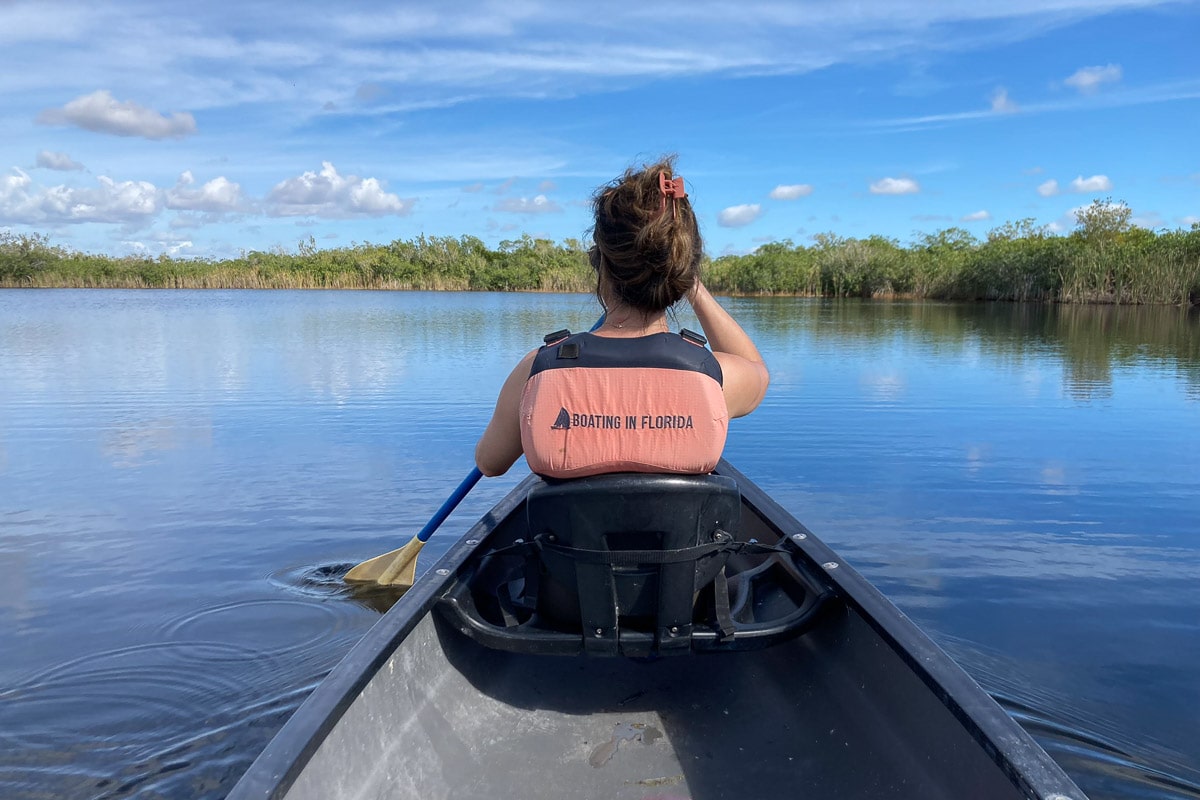
This blog post about what to do in Flamingo in Everglades National Park contains affiliate links. You can read more about our Terms of Use / Disclosure here.
12 Top Things to Do in Flamingo (Everglades National Park)
The location of Flamingo in Everglades National Park makes it a fantastic place to experience a variety of aspects of the park. You’ll have access to both the shallow waters of Florida Bay and the park’s inland ponds and waterways.
As the ultimate destination on a drive through Everglades National Park, this is where you’ll find the most amenities and services anywhere in the park. And thanks to the numerous fun things to do in Flamingo, it’s a fantastic area to spend two or three days in.
Visit the Flamingo Visitor Center
For all kinds of information about Flamingo activities and other Everglades National Park facts, there’s no better place than the Flamingo Visitor Center.
Staffed by friendly park rangers, the visitor center offers exhibits, brochures, maps, and information on trail conditions and current water levels.
Stroll Along the Flamingo Marina
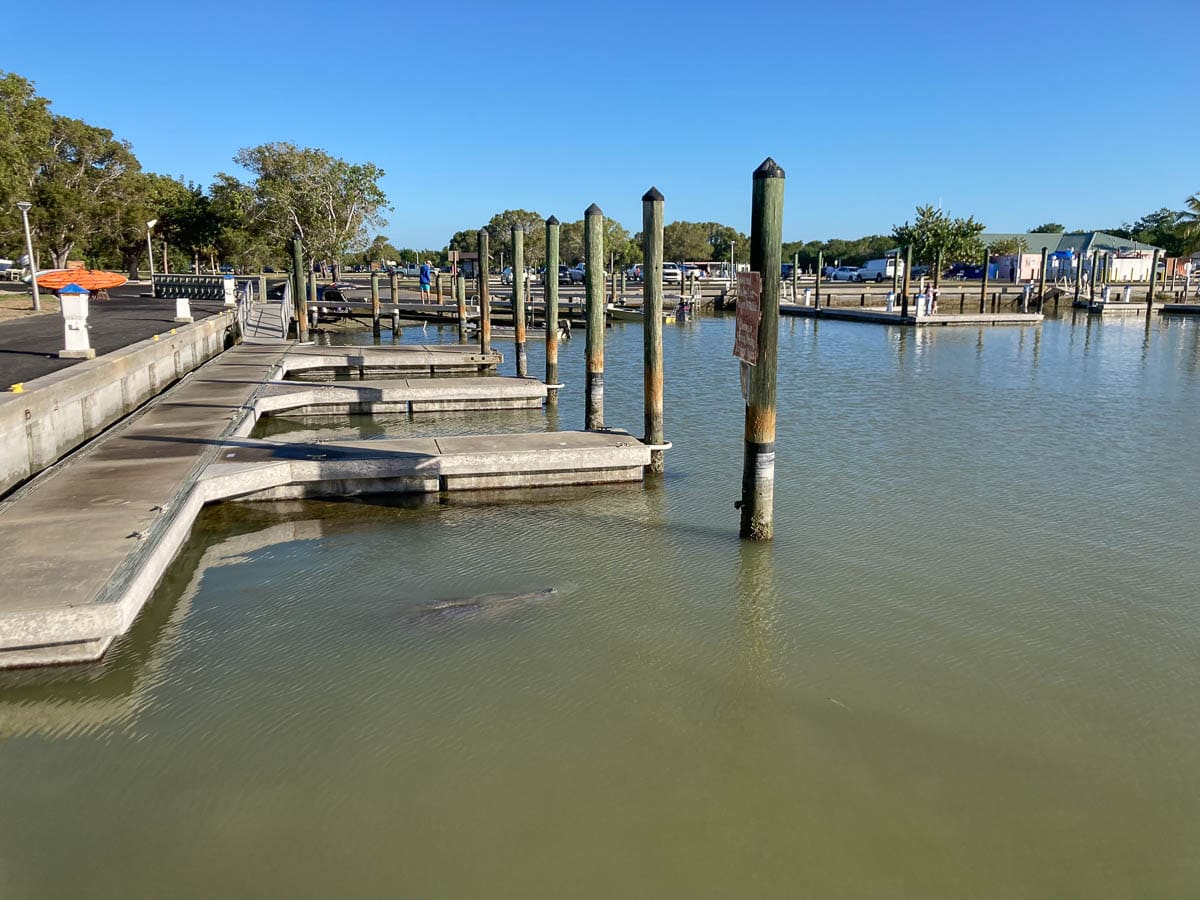
The popular Flamingo Marina, the heart of this part of Everglades National Park, is mere steps from the visitor center.
This is where you’ll find lots of facilities and services, including a marina store, boat ramp, food truck, various tour options, boat and bike rentals, and fuel.
I also recommend simply strolling along the Flamingo Marina, looking up into the trees and down into the water for wildlife.
Many high-profile animals call this area home, from crocodiles and manatees to osprey and herons. (More about all that wildlife below.)
Additionally, the Flamingo Marina is also a wonderful place for a picnic, with tables scattered throughout the park-like landscape. There are great views of Florida Bay, too, while a short shoreline trail—the Guy Bradley Trail—runs to the nearby Flamingo Campground.
Walk Around Eco Pond
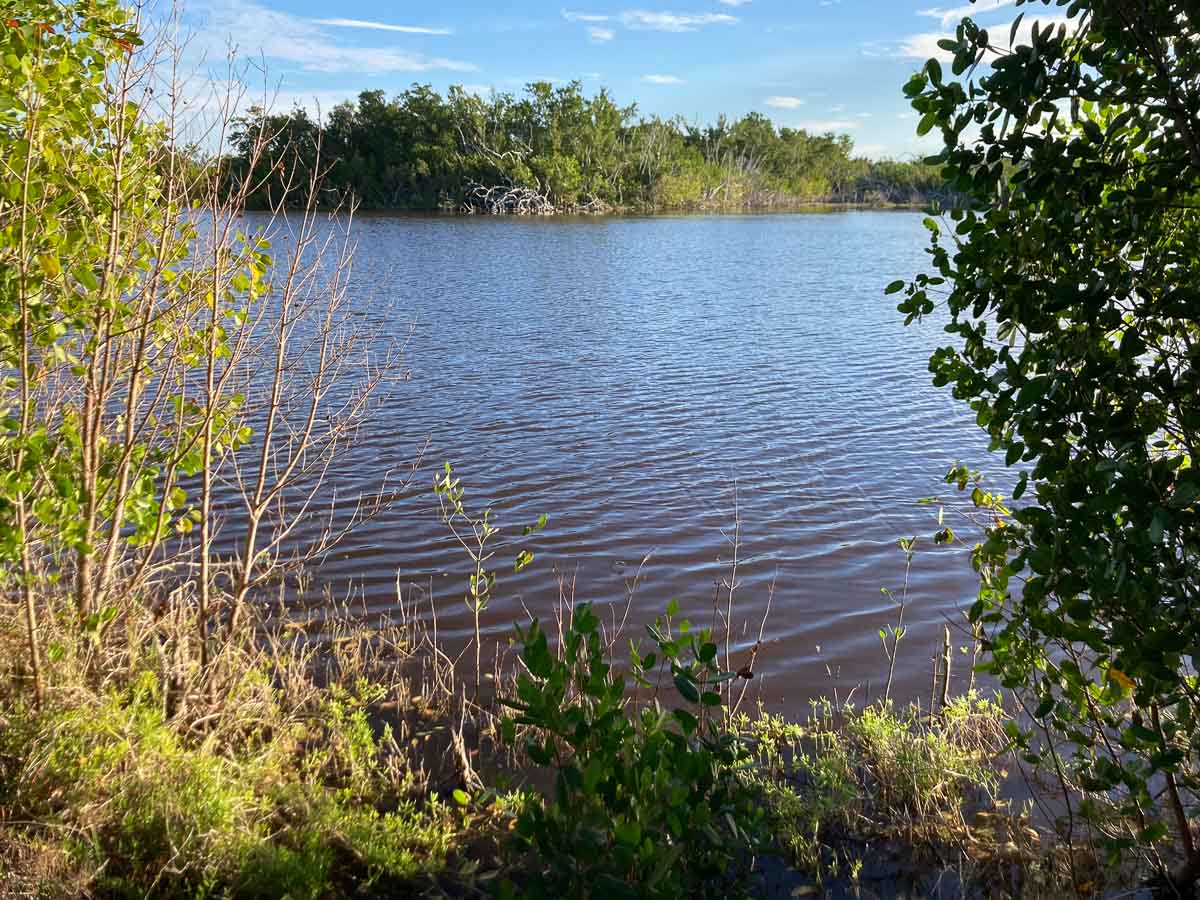
A small pond located between the Flamingo Marina and Flamingo Campground, Eco Pond can be a good place to see Everglades wildlife near the end of the Main Park Road.
Visitors sometimes see alligators here, while turtles often swim around the pond, too. And of course, there are lots of birds to observe.
Look for ducks, anhingas, American coots, and painted buntings, as well as a variety of songbirds and wading birds. Even birds of prey can sometimes be seen here, including red-shouldered hawks and osprey, both of which are common in the general Flamingo area.
You can walk around Eco Pond on a grassy 0.5-mile loop trail, which has a small viewing platform.
See Both Alligators and Crocodiles
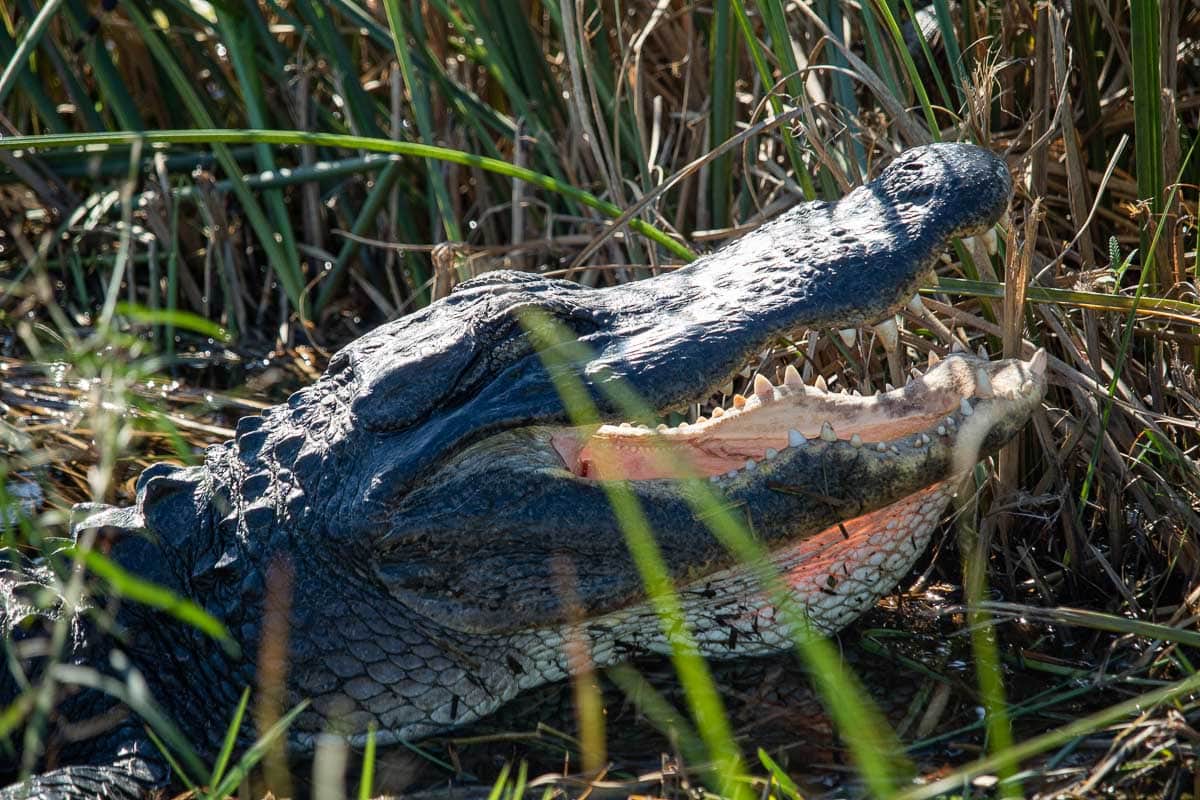
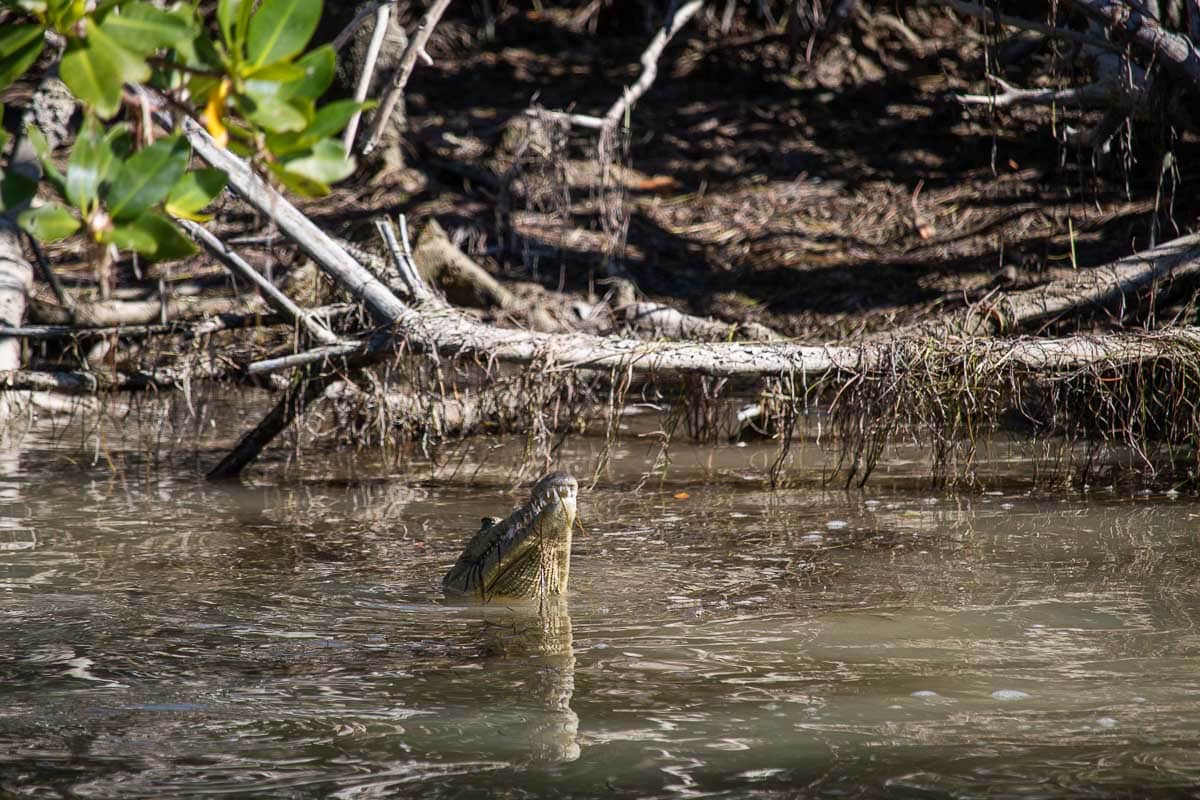
One of the many things that make Everglades National Park so unique is the fact that it’s the only place in the world where crocodiles and alligators live side-by-side.
As I mentioned above, the Flamingo Marina is a superb spot to see American crocodiles in the wild. You can often see one or more lounging on the shore or swimming in the water. Crocodile sightings are also quite common on Flamingo boat tours in Florida Bay.
While crocodiles prefer saltwater, alligators are typically found in bodies of freshwater. If you’re lucky, you might see alligators near Flamingo in places like Eco Pond, West Lake, and Nine Mile Pond.
Learn more about crocodiles and alligators in Everglades National Park here.
Spend Some Time Counting Everglades Bird Species
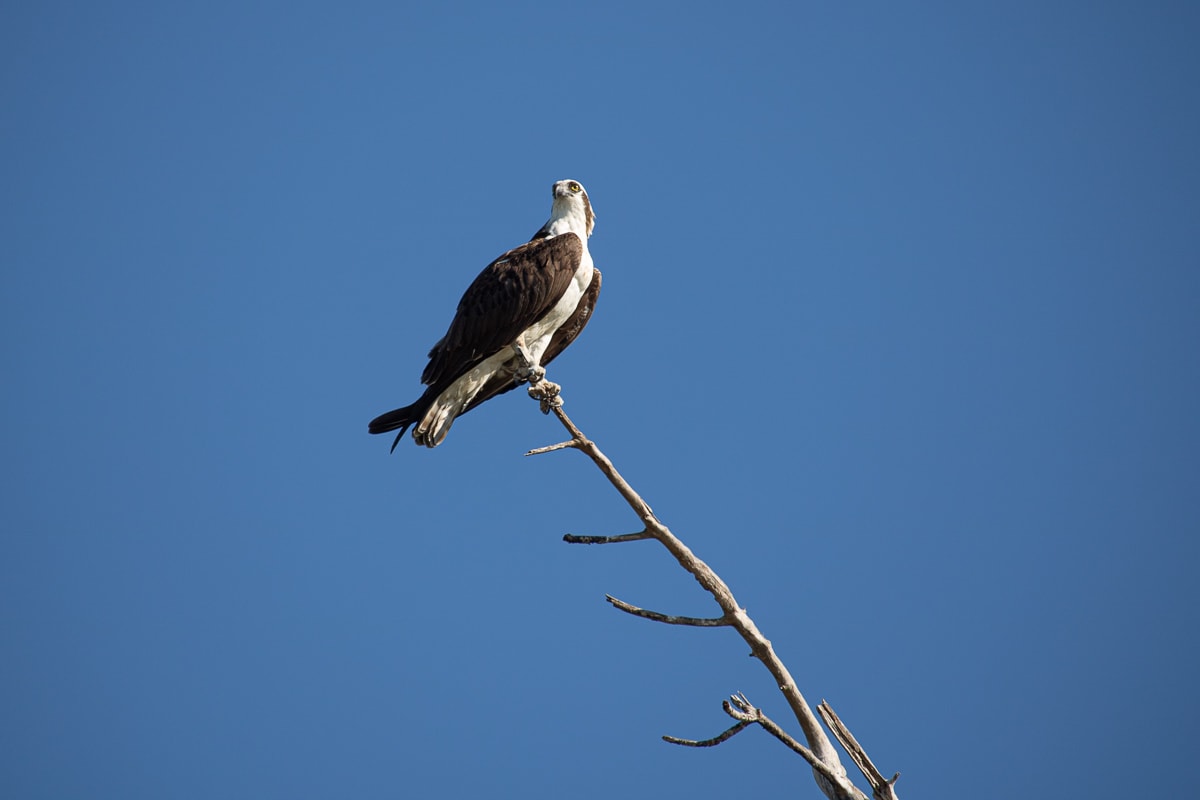
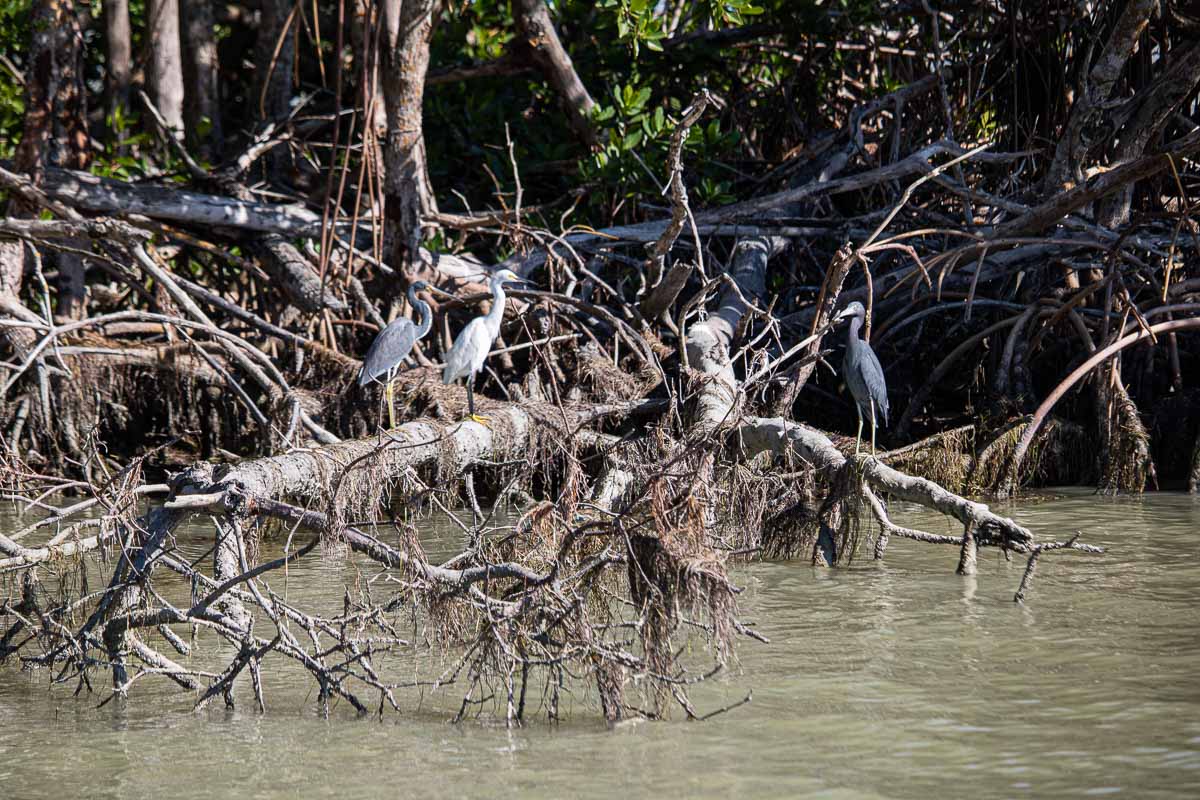
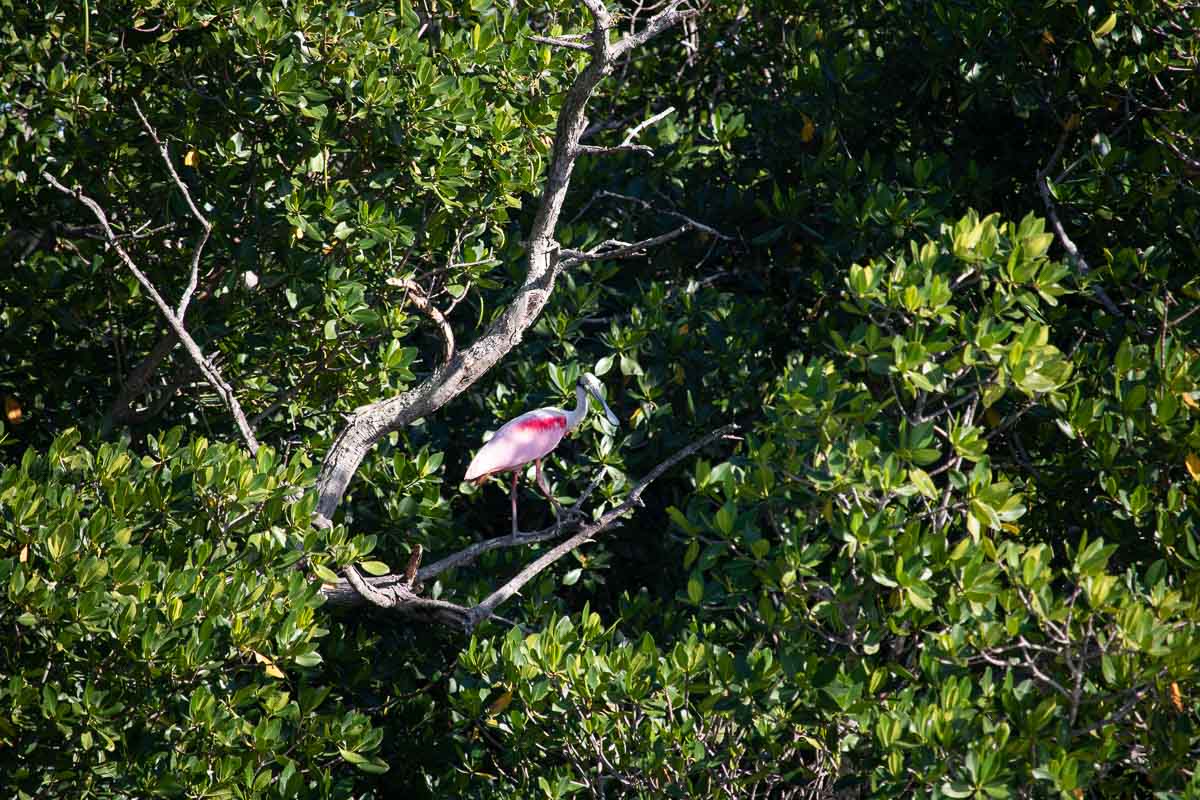
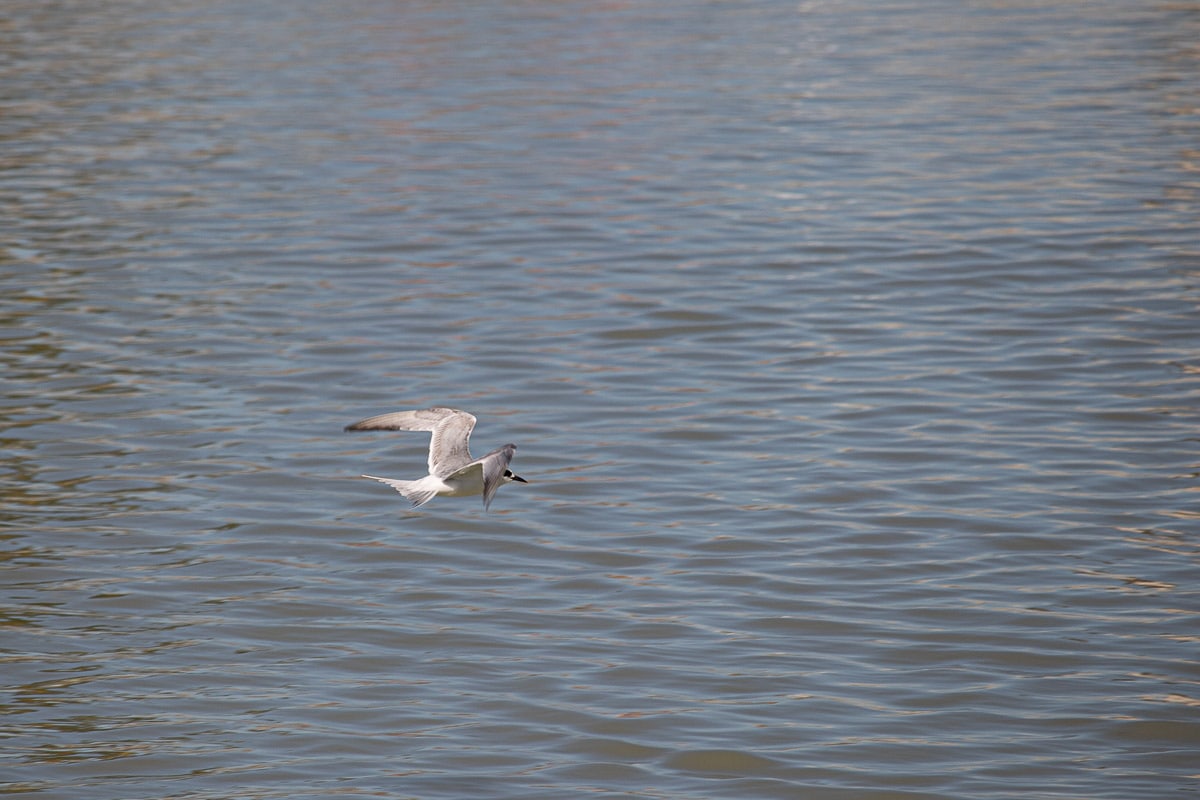
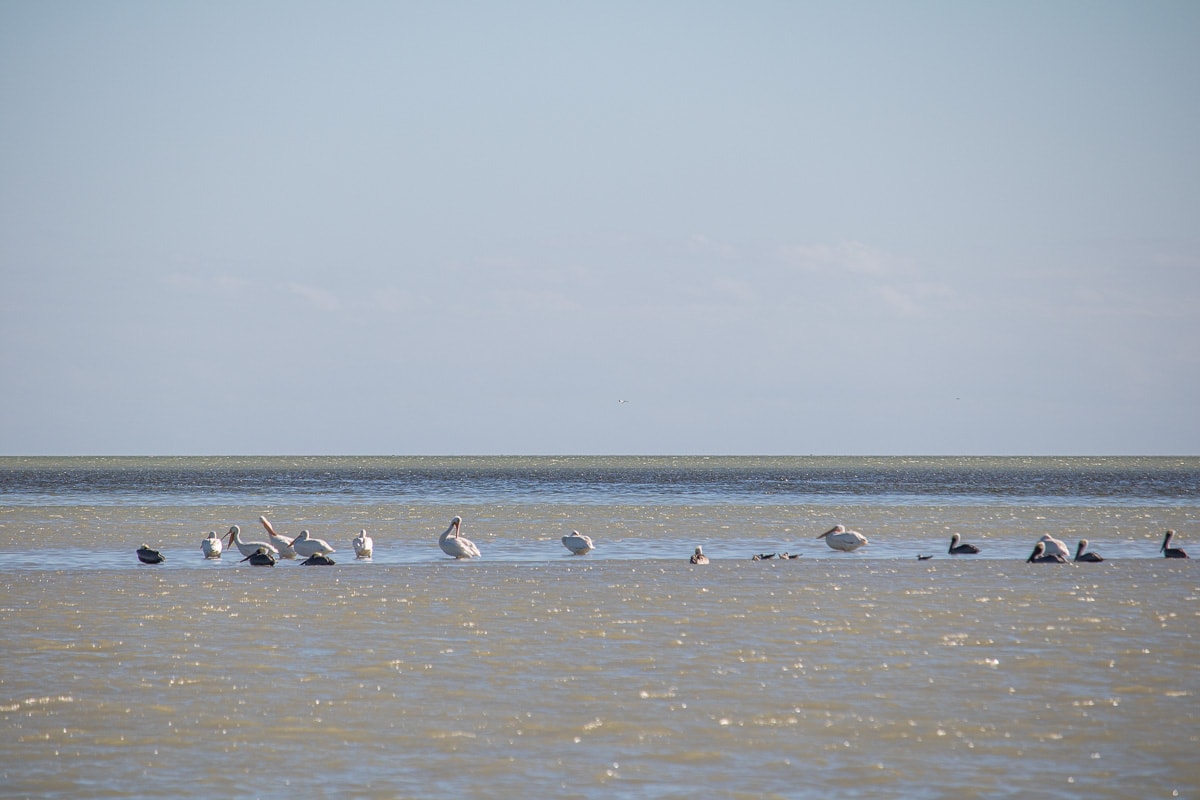
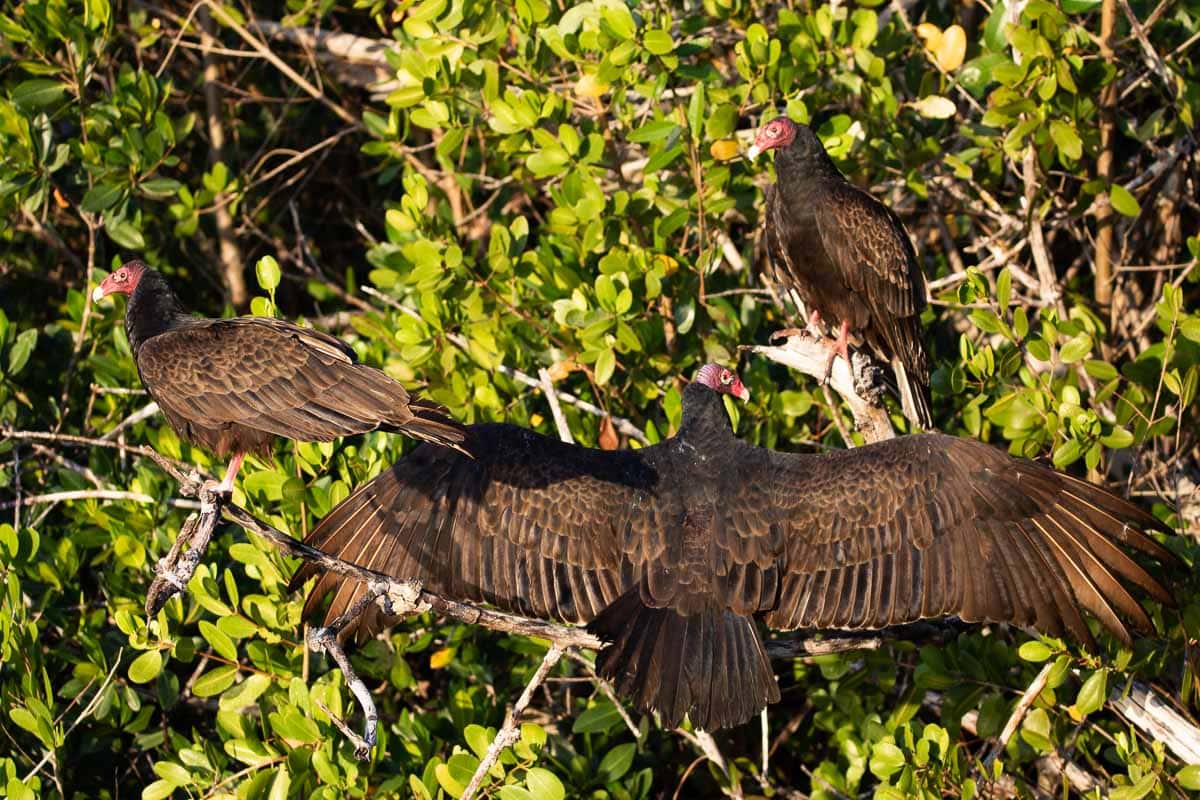
There’s a positively mindboggling number of birds in Everglades National Park. Not just in terms of species, but also in sheer cumulative numbers.
Over 360 bird species have been observed in the Everglades, including several wading birds, which are present in the park in sometimes enormous colonies.
In fact, Everglades National Park was created in 1947 with the specific purpose of protecting the region’s subtropical wetlands and extraordinary biodiversity. Especially the remarkable diversity of birds in the Everglades—and their rapidly declining numbers—was a main reason for the park’s establishment.
Nowadays, you can still see huge numbers of birds throughout the park and Flamingo happens to be one of the best bird watching areas.
Thanks to its location at the intersection of saltwater Florida Bay and inland freshwater canals and ponds, the Flamingo area is home to a wide variety of birds.
During my two days in Flamingo, I didn’t precisely count the bird species I saw, but it was easily well over two dozen.
My sightings included various wading birds, such as tricolored herons, green herons, roseate spoonbills, white ibises, night-herons, and snowy egrets.
Other birds I saw included osprey, red-shouldered hawks, white and brown pelicans, black and turkey vultures, terns, woodpeckers, and kingfishers. Flamingo truly is a bird watcher’s paradise.
Join a Guided Boat Tour From Flamingo
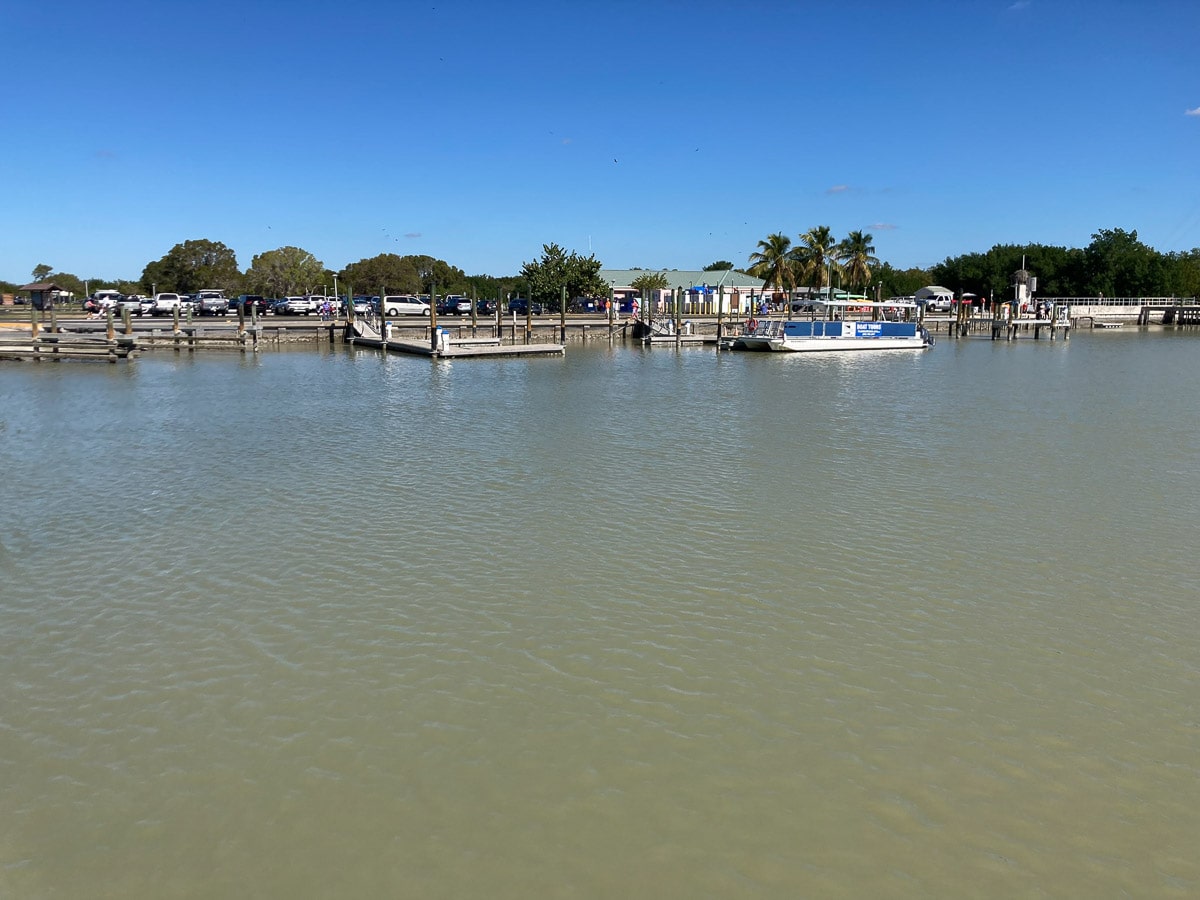
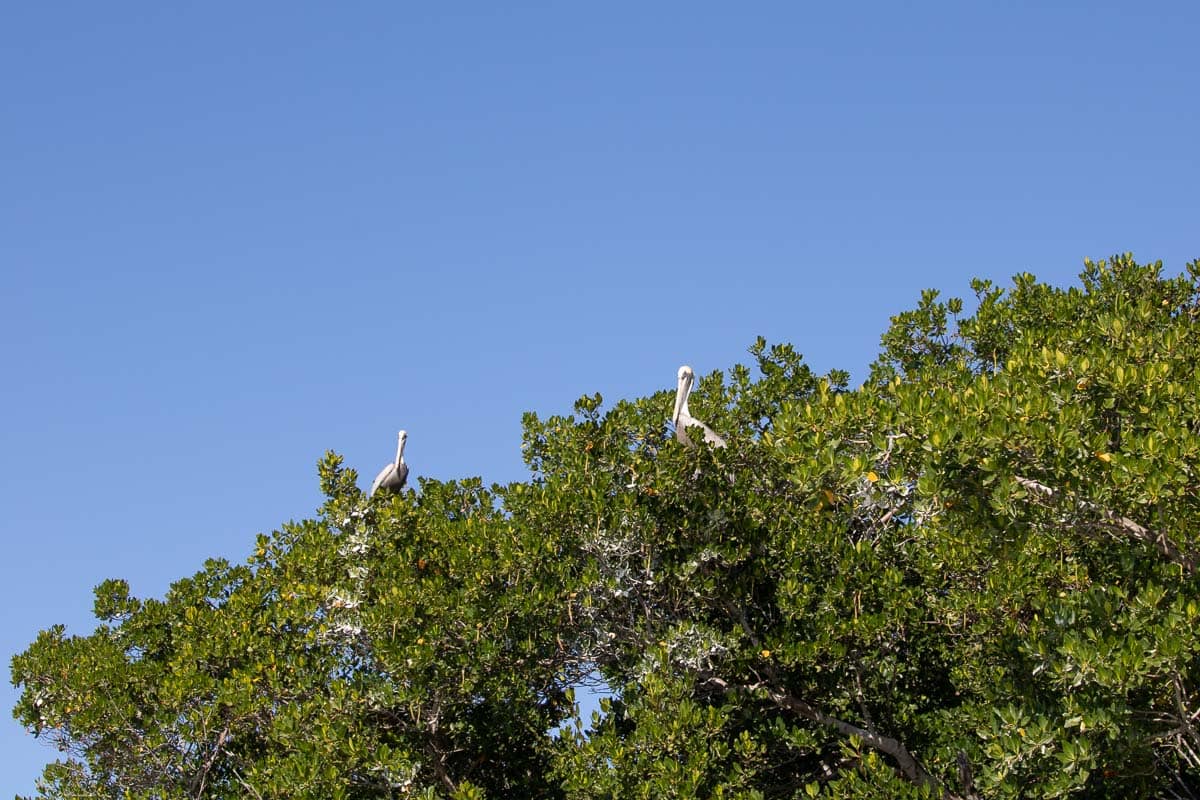
Provided by Flamingo Adventures, one of the official concessioners of Everglades National Park, there are two different boat tours from the Flamingo Marina, which take place multiple times a day (depending on water levels).
You can choose between Florida Bay boat tours and backcountry boat tours.
- Florida Bay boat tours, as the name implies, will take you into the wildlife-rich waters of Florida Bay and to a few famous keys. These tours take place every day at 4 pm, from November 1 through April 30.
- Backcountry boat tours venture out into the Buttonwood Canal, through Coot Bay and into sprawling Whitewater Bay. These tours are offered every day throughout the year (weather-permitting) at 9 am, 11 am, 1 pm, and 3 pm.
Whether you’re also canoeing or kayaking or not, I still highly recommend joining a guided boat tour, too.
I went on a guided boat tour into Florida Bay, where I learned more about the human history of the area. I also saw a few iconic animals I hadn’t seen in the park thus far, including a crocodile, roseate spoonbill, and pelicans.
These tours are narrated by a wildlife biologist and offer a totally different perspective. They also allow you to go further into the wilderness than a muscle-powered paddling trip might.
All things considered, boat tours are easily one of the best things to do in Flamingo, Everglades National Park.
Go Canoeing or Kayaking in the Everglades
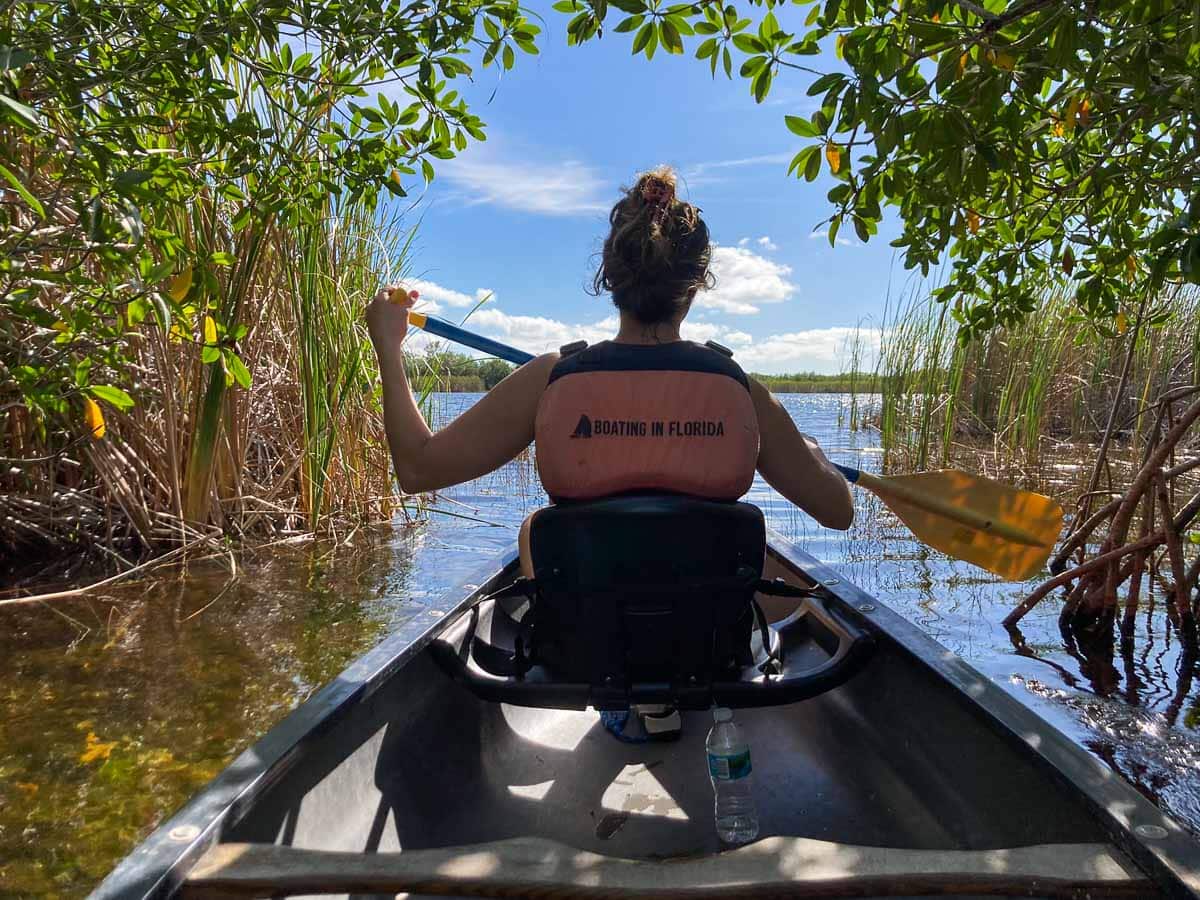
Flamingo is a fantastic starting point for canoe or kayak trips in the Everglades. You can pick up both canoe and kayak rentals at the Flamingo Marina.
Paddling trips that begin at the marina include excursions into Florida Bay and outings up the Buttonwood Canal. Wildlife sightings are all but guaranteed during these self-guided water-based adventures.
Another very popular place to explore by canoe or kayak is Nine Mile Pond. The scenic 5-mile Nine Mile Pond Canoe Trail passes through a shallow sawgrass marsh and past scattered islands of mangroves.
In terms of Everglades wildlife viewing, this is an amazing area, referred to by the National Park Service as “a productive freshwater canoeing area.”
Along the way, keep an eye out for both alligators and crocodiles, turtles, as well as the abundance of bird species that is so typical of the Everglades.
Look for wading birds like wood storks, roseate spoonbills, herons, limpkins, and egrets. Other birds you might see include snail kites and white-crowned pigeons.
Watch Manatees in the Flamingo Marina Water
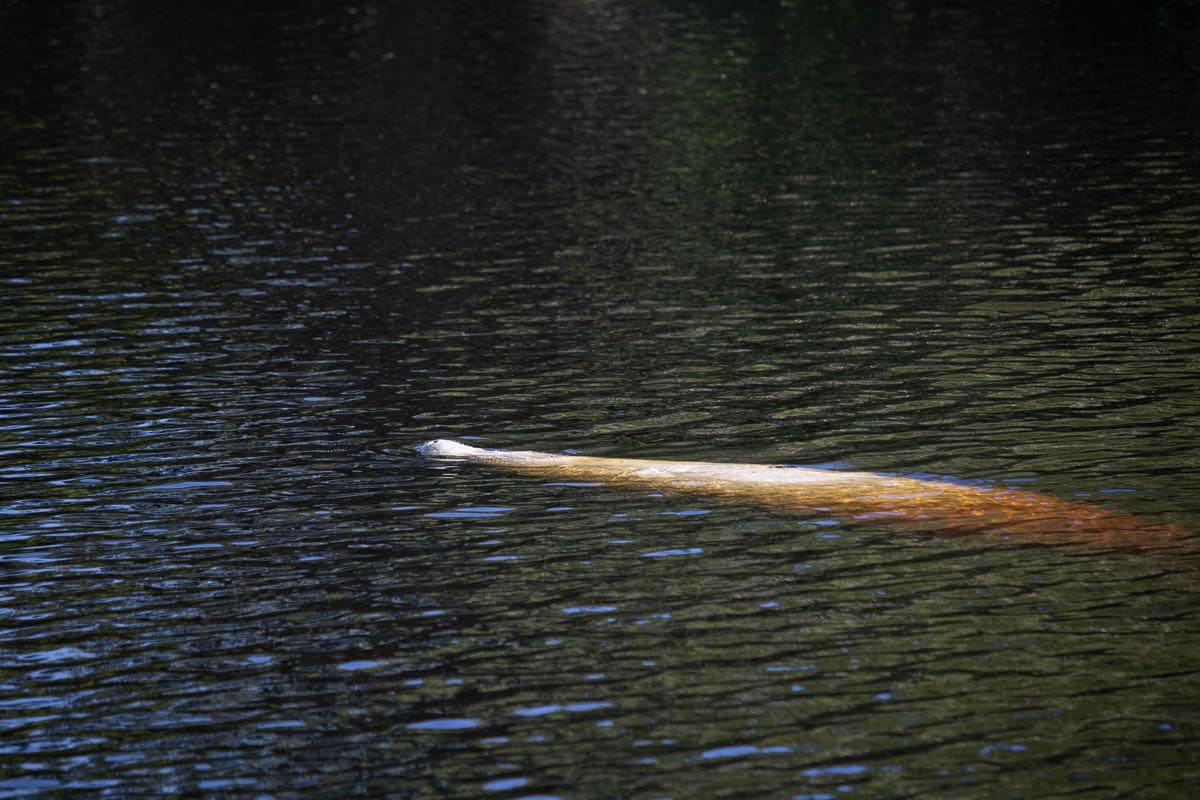
“Manatees may not win the gold in a beauty contest, but they definitely take the prize for popularity,” the National Park Service says. “Whether it’s their sad, puppy-like demeanor or their sluggish, gentle manner, something about manatees is awfully endearing.”
Seeing manatees swim in the murky water is one of the absolute highlights of Flamingo. And you don’t have to do much to enjoy this unique experience.
These large marine mammals casually hang out in the Flamingo Marina throughout the year. Although sightings aren’t guaranteed, they are very common, indeed. I saw several manatees during the couple of days I spent in Flamingo, including a mother and a calf.
Hike or Bike the Snake Bight Trail
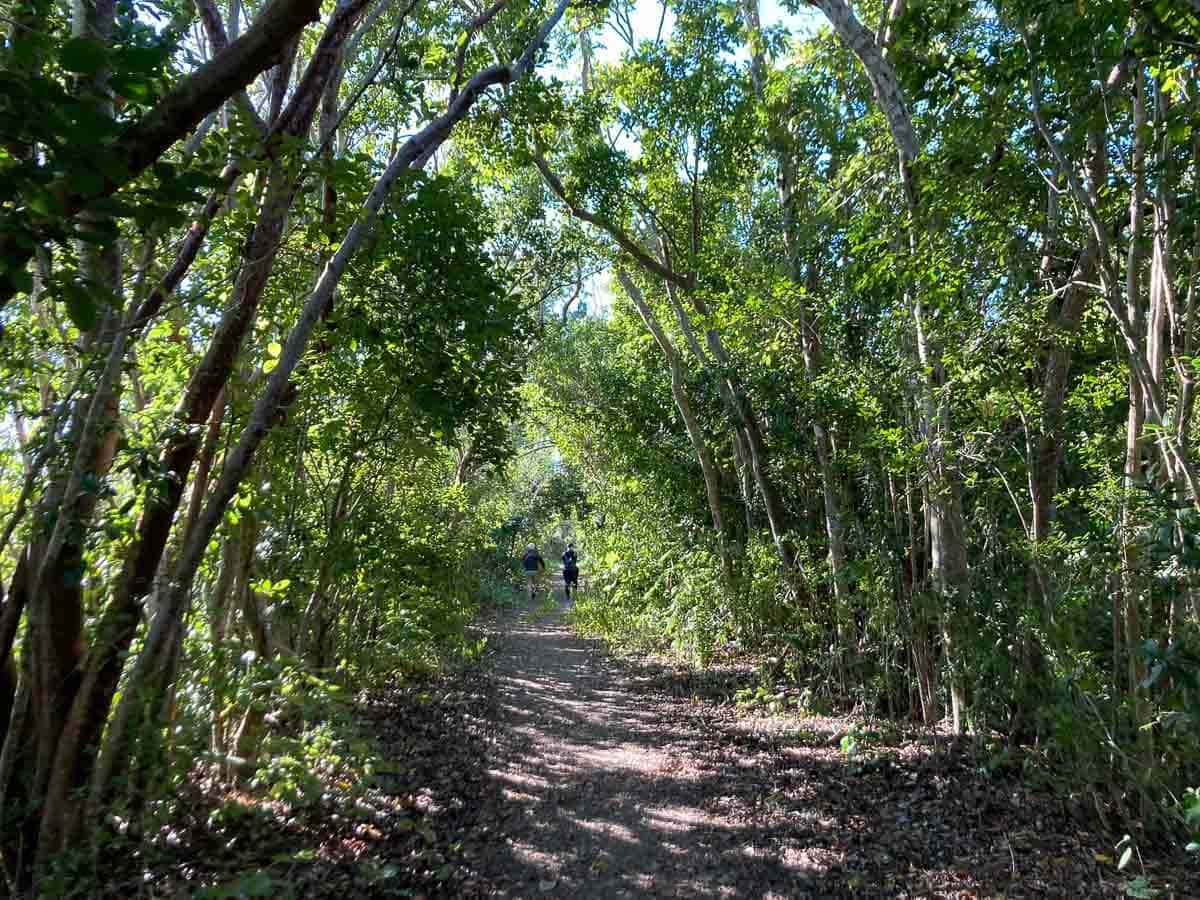
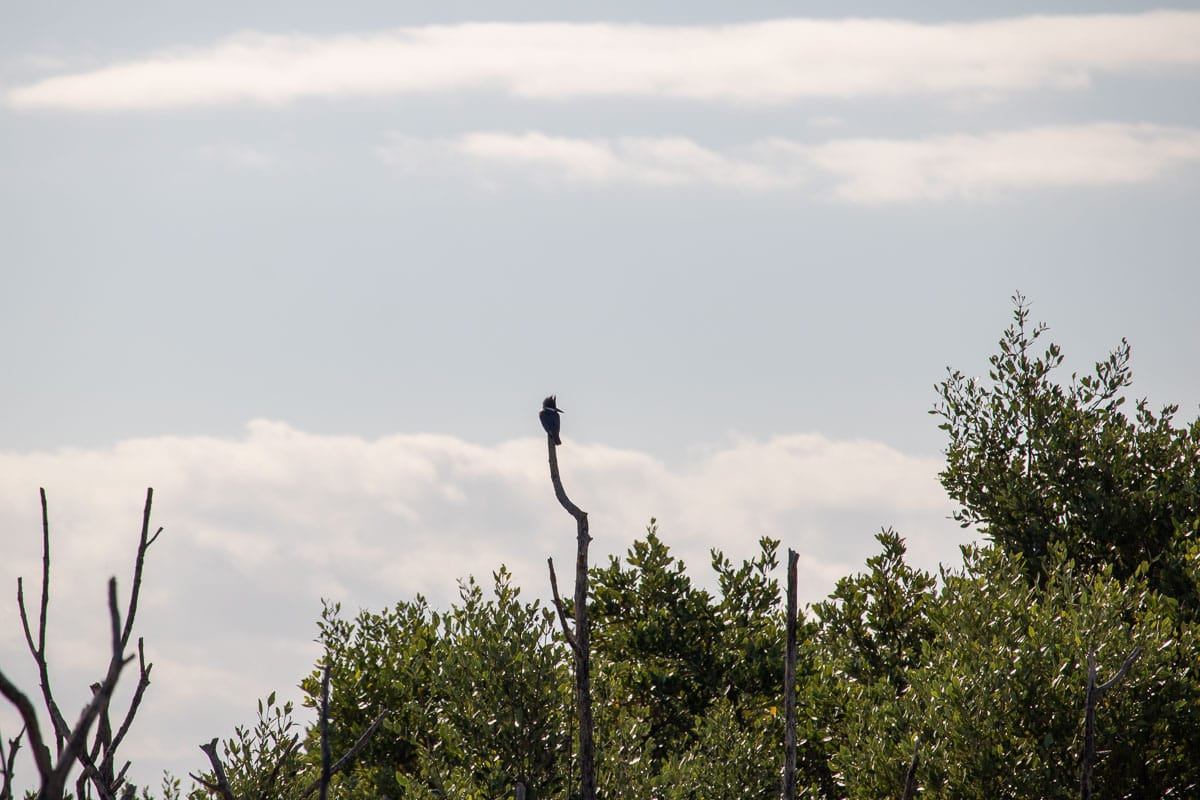
One of the longer trails in Everglades National Park, the Snake Bight Trail is great for a wildlife-centric hike or bike ride.
Located about four miles north of the Flamingo Visitor Center, the trail parallels the Snake Bight Canal. Flanked by the dense vegetation of a tropical hardwood hammock, it offers great opportunities to see woodland birds like warblers and mangrove cuckoos.
The Snake Bight Trail ends on a boardwalk on the shore of Snake Bight, which is a phenomenal spot to see wading birds, shore birds, and occasionally even flamingos. Try to be there around high tide, which is when most of the birds will be feeding.
Snake Bight itself—a bight is a small bay within a larger bay, in this case Florida Bay—is home to numerous marine animals, including manatees, dolphins, crocodiles, and countless fish. Those animals are, however, rarely seen from the boardwalk.
By itself, the Snake Bight Trail is 3.2 miles roundtrip. You can either hike or bike it.
If you are planning on biking in the Everglades, I recommend combining the Snake Bight Trail with the Rowdy Bend Trail. Starting at the Flamingo Marina, which has bicycle rentals, this roundtrip bike ride is 12.6 miles.
Note: The Snake Bight Trail is notorious for its mosquitoes. During the wet season, they’re present in such an abundance that many hikers end up turning back. For that reason, I recommend either wearing long sleeves and pants and applying lots of insect repellent, or doing this hike in the dry season.
Go Fishing at Flamingo in Everglades National Park
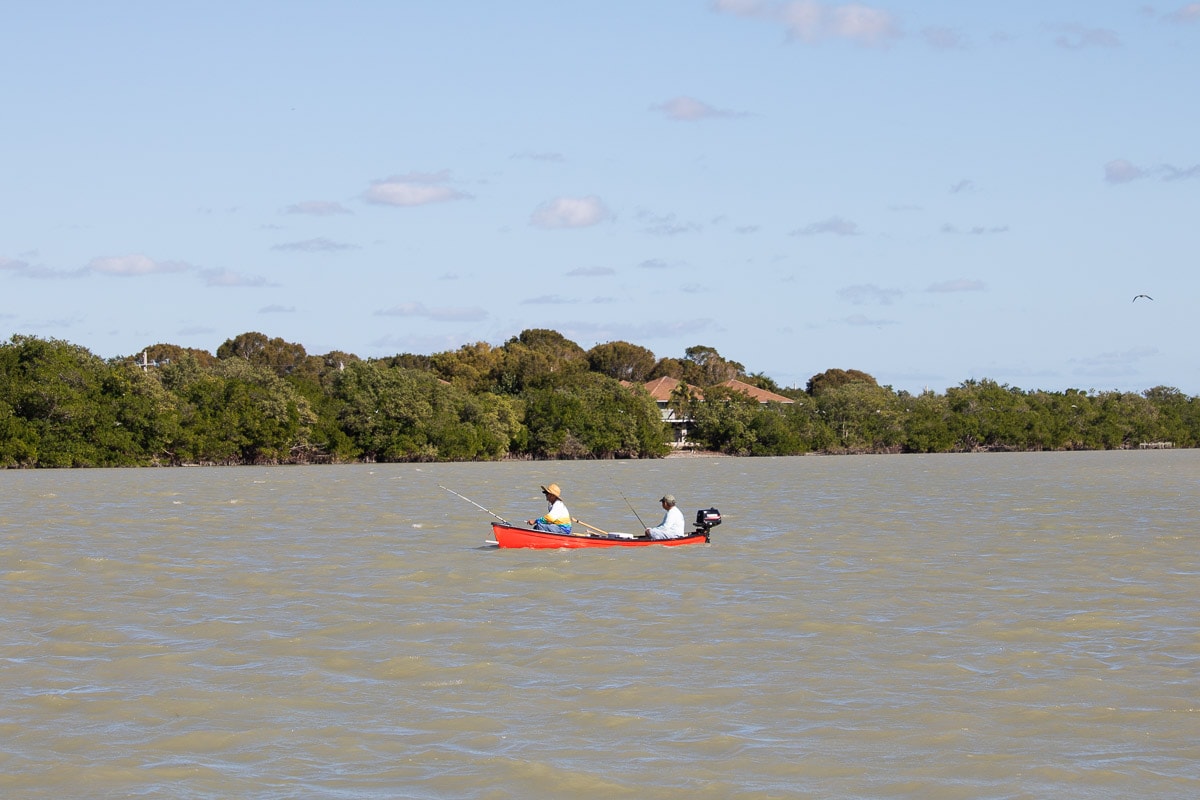
“One third of Everglades National Park is covered by saltwater, the rest is a freshwater wetland. Both offer ample opportunity for recreational fishing,” as the National Park Service so invitingly puts it.
Flamingo sits right in the middle of that watery wonderland, offering access to both saltwater Florida Bay and numerous freshwater ponds and waterways.
As such, this is one of the most popular fishing destinations in Florida, if not the entire United States.
You can find more information about fishing in Flamingo and Everglades National Park, including permits, regulations and limitations, here on the park’s website.
Stay at the Flamingo Eco-Tents
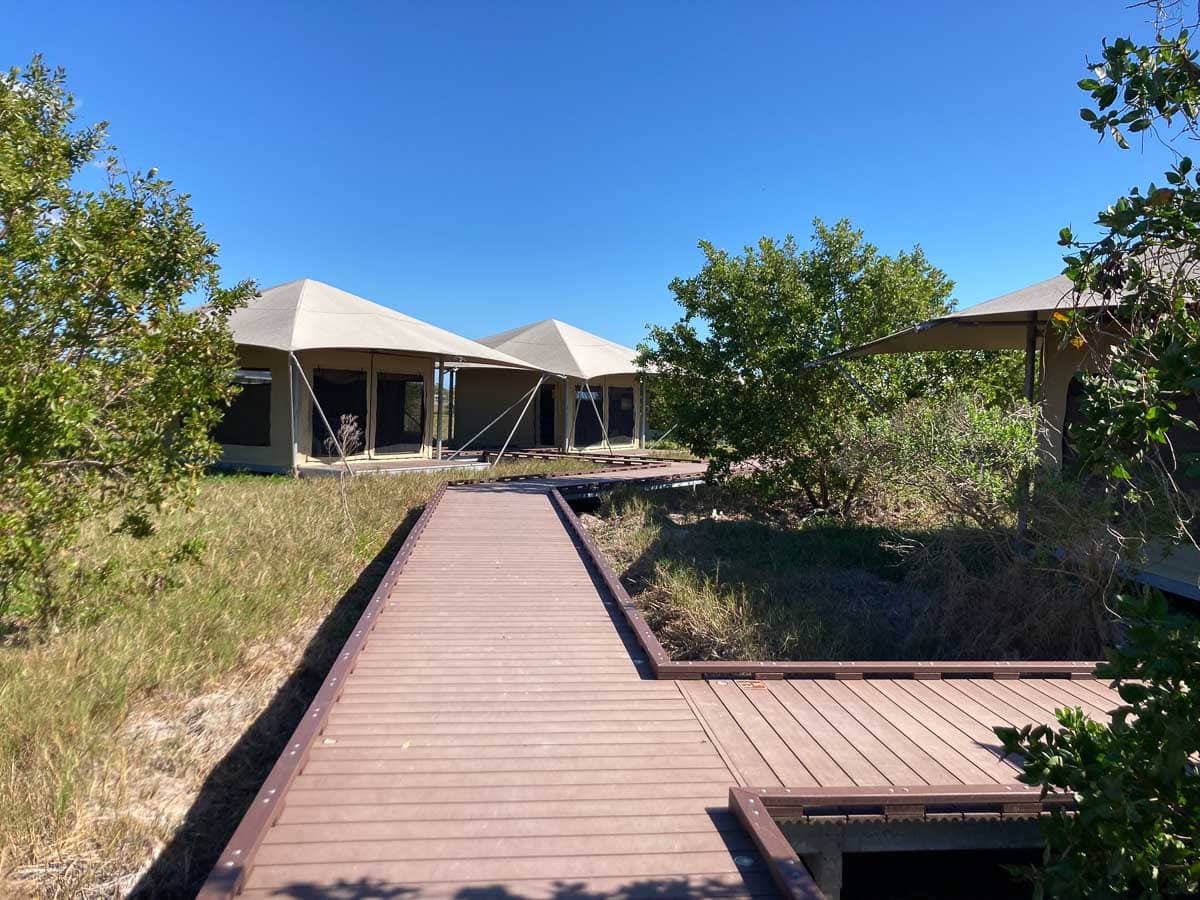
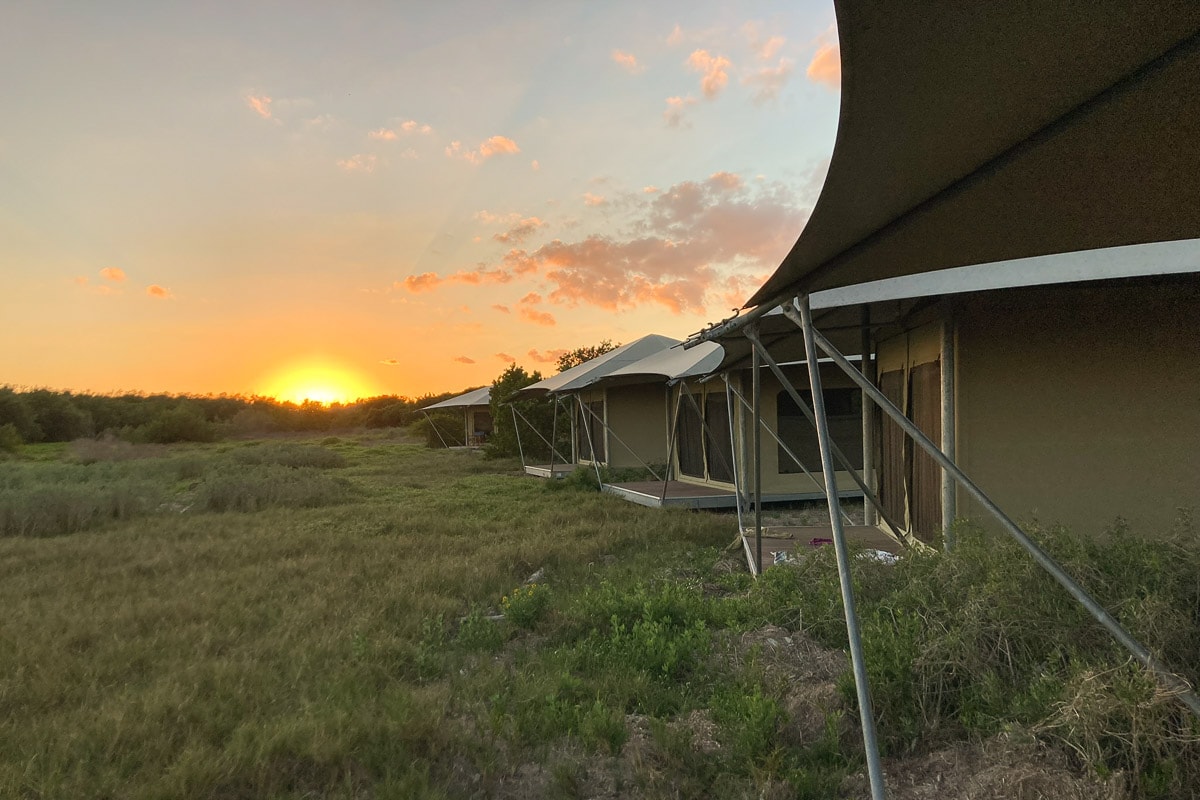
At the very end of the Everglades Main Park Road, you’ll find the Flamingo Campground and Flamingo Eco-Tents.
This sprawling campground offers wonderful views of Florida Bay—it’s especially amazing at sunset—and access to the Coastal Prairie Trail, Bayshore Trail, and Guy Bradley Trail, which, as I said above, links the campground and the Flamingo Marina.
I spent a couple of nights glamping at the Flamingo Eco-Tents, which was an experience I’d recommend to everyone. Accessible via a boardwalk, those large canvas tents are the absolute perfect base to explore the greater Flamingo area.
And even if you’re not camping or glamping in Everglades National Park, the wide-open views of Florida Bay make this campground worth visiting. It’s a great place for picnicking and bird watching, too.
Enjoy a Sunrise Walk on the West Lake Boardwalk Trail
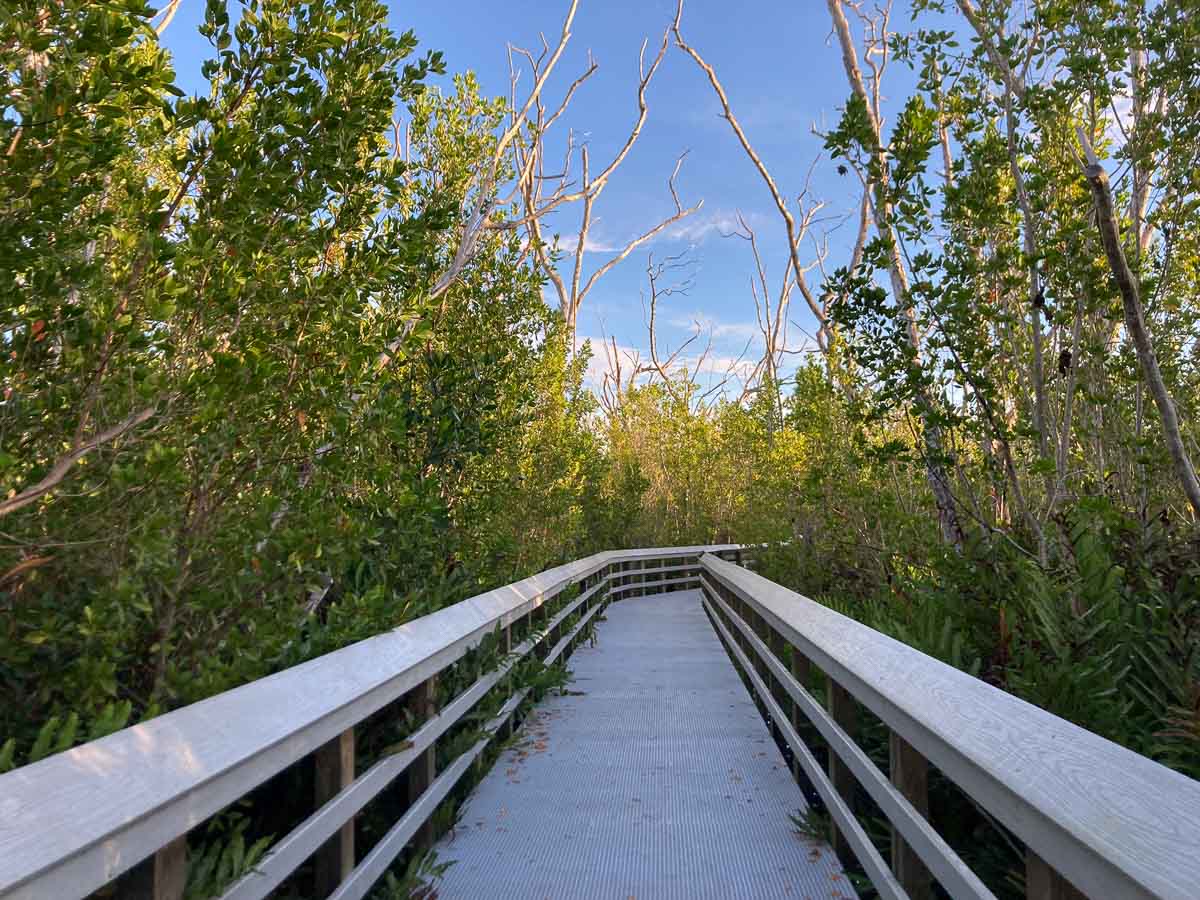
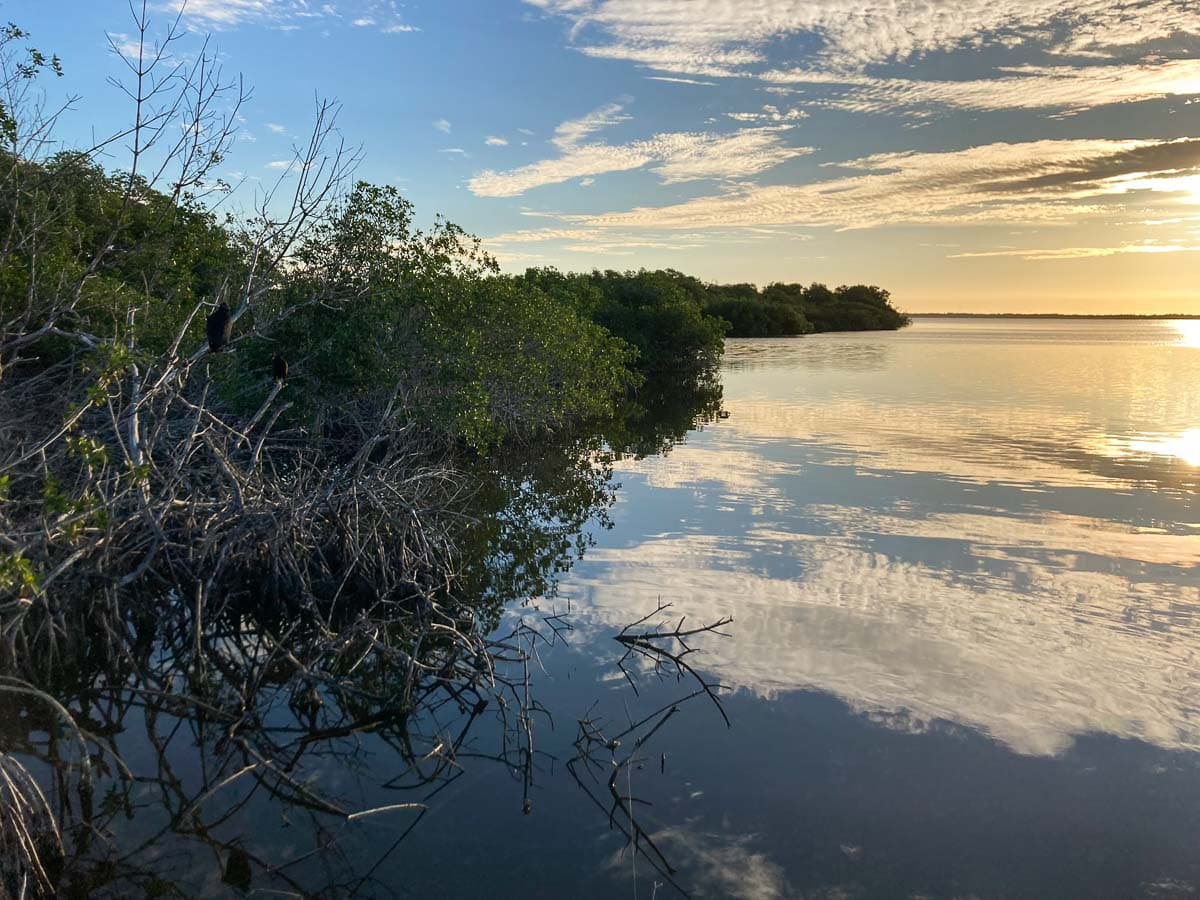
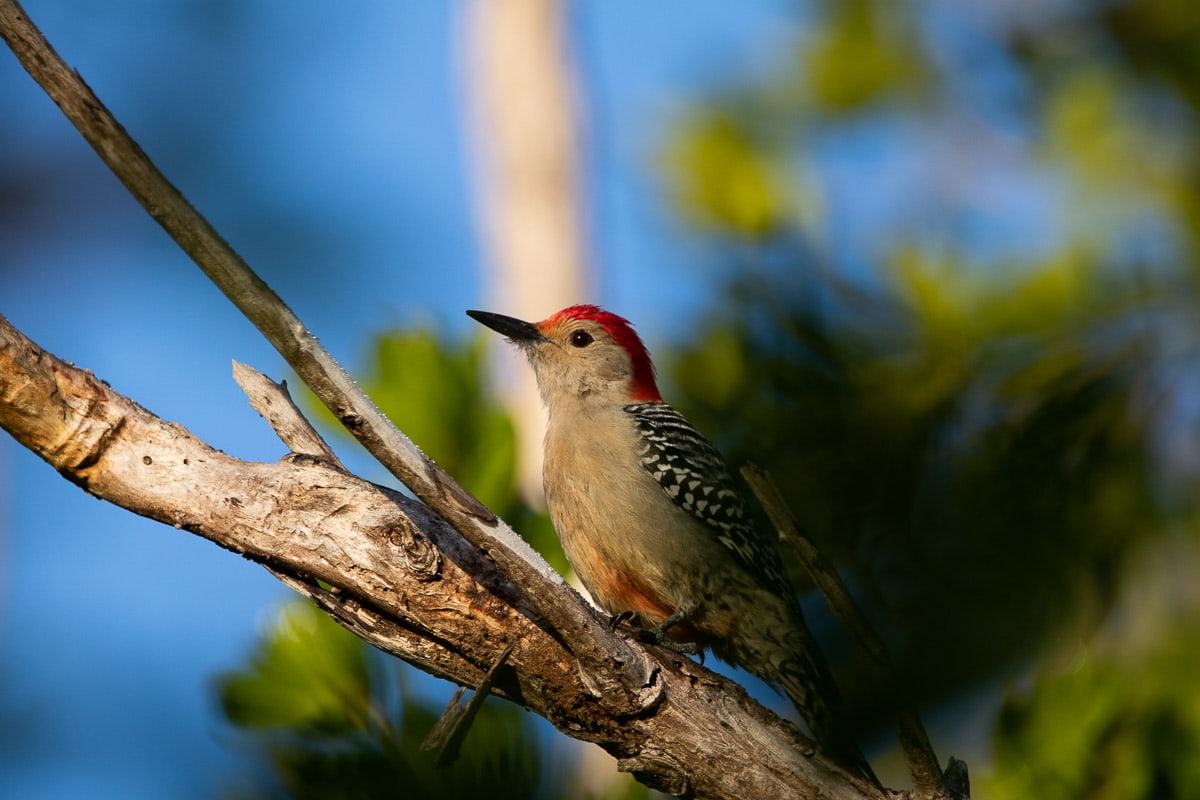
One of my favorite things to do near Flamingo Everglades was walking the West Lake boardwalk in the morning. I recommend walking this short boardwalk trail through the mangroves, a 0.5-mile loop, at sunrise.
The scenery is spectacular at dawn, the lake’s water perfectly reflective and still, the air thick with the songs and calls of birds. Most likely, you’ll also be all by yourself here early in the morning.
Along this short boardwalk, you can learn about the three different types of mangroves—white, black, and red—while listening to the wildlife that inhabits these aquatic forests.
I saw a variety of birds here, including woodpeckers, a few species of songbirds, vultures, egrets, and herons.
The West Lake boardwalk is beautiful any time of the day, though, but it does get busier as the day progresses. For peace, quiet, solitude, and the some of the best bird watching opportunities near Flamingo, go as early in the morning as you can.
Wildlife Safety at Flamingo, Everglades National Park
One of America’s most biodiverse places, the Everglades are home to innumerable species of animals. This includes several that can be potentially dangerous to humans, from the smallest of insects to the largest of reptiles.
Mosquitoes
During certain times of the year, mosquitoes can be a real nuisance in Everglades National Park, including the Flamingo area.
Especially during the wet summer months, on overcast days, and at dawn and dusk, these tiny buzzing insects are plentiful. You can avoid (most of) the mosquitoes be staying away from grassy areas and shady places.
To protect yourself from mosquitoes and the possible diseases they may carry, consider wearing long sleeves and pants, and using a strong insect repellent.
Important note: The Aedes species of mosquitoes that could carry the Zika virus is found in southern Florida. However, these mosquitoes are much more prevalent in urban areas than in wilderness areas. You can learn more about the Zika virus here.
Venomous Snakes
There are more than two dozen species of snakes in Everglades National Park, including a few invasive species—most notably the huge Burmese pythons. Of all those snakes, four are venomous:
- Florida cottonmouth
- Eastern coral snake
- Eastern diamondback rattlesnake
- Dusky pygmy rattlesnake
It’s possible to encounter snakes, including venomous ones, pretty much all throughout the Flamingo area. Watch where you put your feet, especially in grassy areas, and where you place your hands and paddles when canoeing or kayaking.
When you see or hear a snake, do not approach it and leave the area calmly. Snakes want to be left alone and will bite only when provoked, cornered, or surprised at close range.
You can learn about rattlesnake safety here.
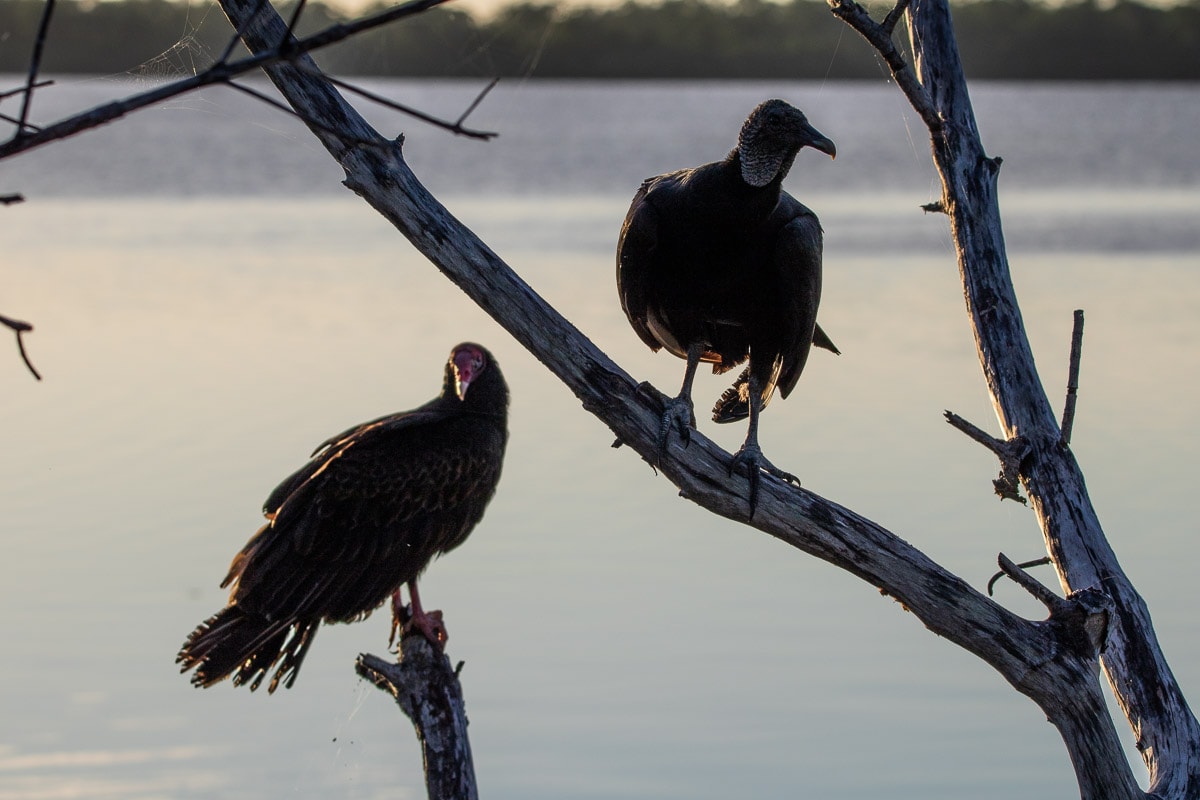
Vultures
Although vultures don’t pose a physical threat to humans, they do, somehow, seem to be attracted to the rubber on vehicles. According to the National Park Service, they “have been known to cause severe damage to windshields, sun roofs, and windshield wipers.”
In many parking lots throughout Everglades National Park, you’ll see signs warning visitors about potential damage to vehicles caused by vultures.
While there’s not a whole lot you can do to completely protect your vehicle, the Park Service does offer a few suggestions:
- Avoid parking near groups of vultures
- Park in full sun
- Use a car cover
- Cover exposed rubber with a wet sheet or towel
- Use loud noises to spook vultures off vehicles
- Notify a ranger
Alligators and Crocodiles
According to the National Park Service, “human conflicts with alligators are rare and generally not serious, but incidents do occur and have been reported.”
Concerning crocodiles, the agency says that “although the aggressive reputation earned by the American crocodile’s distant, larger, man-eating cousins in Australia and Africa may inspire fear of crocodiles inhabiting the Everglades, conflict with humans rarely occurs because of the shy nature of American crocodiles.”
Most alligator attacks on humans are the result of illegally feeding the alligator. This makes the animal less skeptical of humans and bolder, often causing the alligator to attack instead of flee.
An average Everglades crocodile is smaller than an alligator and will usually enter the water whenever a person approaches. This might come with some splashing, which is not a threatening behavior. Instead, a crocodile splashing in the water indicates it’s scared and stressed.
Generally speaking, neither alligators nor crocodiles are considered dangerous to humans. They don’t see humans as prey and do not actively hunt people.
That said, though, it’s still important to be careful when recreating in alligator and crocodile country. This is especially true near the water’s edge, whether it’s a canal, pond, river or marsh.
Avoid behaving like a prey animal might and keep children and pets away from the waterline. The park advises people to stay at least 15 to 20 feet from the shoreline and from any alligators or crocodiles you might come across.
The Park Service reminds visitors that “touching an alligator is never a good idea. Feeding or harassing an animal, including throwing objects at it, is a criminal offense that carries a fine. Any action that alters the natural behaviors of an animal is harassment.”
Additionally, as I mentioned above, swimming and snorkeling is prohibited everywhere in the park.
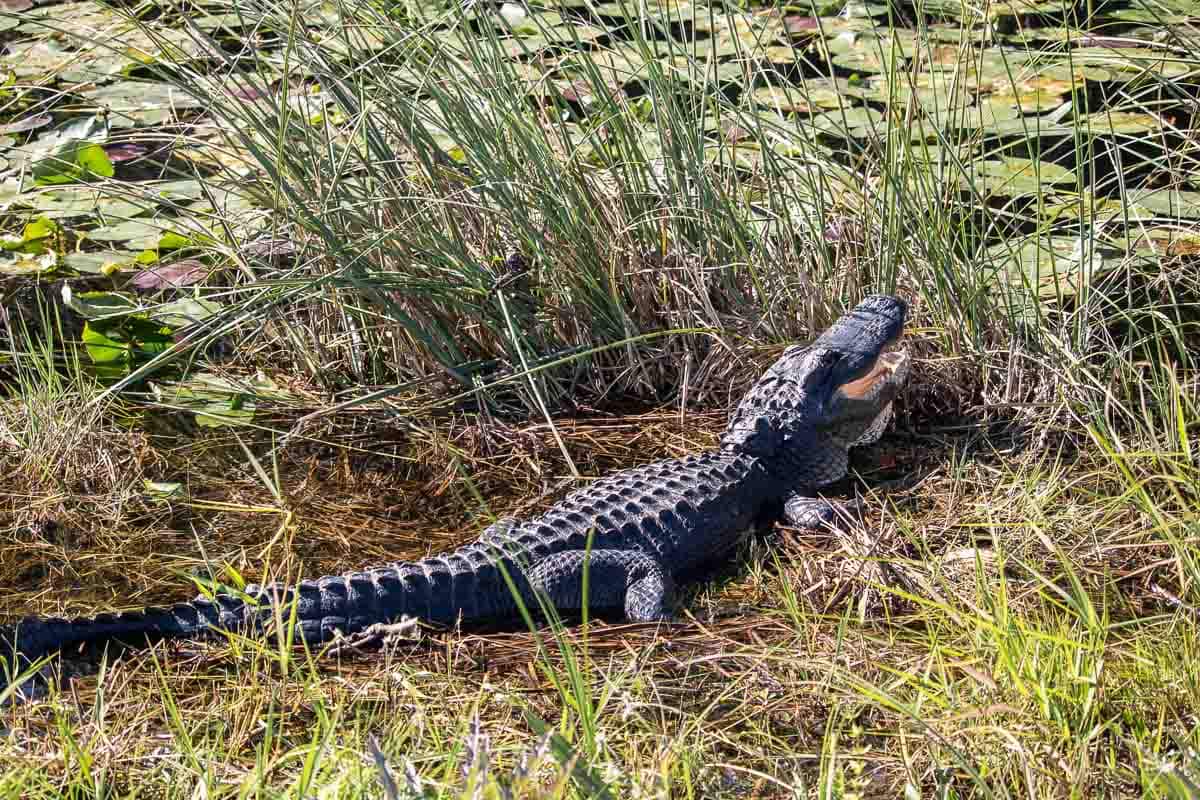
More About Everglades National Park
- Park Website
- Travel Guide
- Topographic Map
- Where to See Wildlife in Everglades National Park
- Where to See Alligators and Crocodiles in the Everglades
- Famous Birds of the Everglades
- Top Sights on the Everglades Main Park Road
- Top Things to Do in Shark Valley
- Best Everglades Bike Trails
- Accommodation
Visiting Everglades National Park’s Flamingo FAQs
Where Is Flamingo in Everglades National Park?
Flamingo sits on the shore of Florida Bay near the southernmost point of the Florida peninsula. It is at the end of the Main Park Road, which runs through the heart of the park from the Ernest F. Coe Visitor Center near Florida City and Homestead.
Here are some driving distances (and times) from other popular destinations in south Florida, such as Biscayne National Park, Miami Beach, and Key West:
- Florida City to Flamingo: 47 miles (1 hour)
- Homestead to Flamingo: 48 miles (1 hour 5 minutes)
- Biscayne National Park to Flamingo: 57 miles (1 hour 20 minutes)
- Miami Beach to Flamingo: 90 miles (2 hours)
- Miami International Airport (MIA) to Flamingo: 81 miles (1 hour 45 minutes)
- Fort Lauderdale to Flamingo: 111 miles (2 hours 10 minutes)
- Fort Lauderdale-Hollywood International Airport (FLL) to Flamingo: 111 miles (2 hours 10 minutes)
- Key Largo to Flamingo: 69 miles (1 hour 30 minutes)
- Key West to Flamingo: 172 miles (3 hours 45 minutes)
- Shark Valley (Everglades National Park) to Flamingo: 87 miles (2 hours)
- Everglades City to Flamingo: 131 miles (2 hours 45 minutes)
How Many Days Do I Need to Explore Flamingo?
While you can visit Flamingo in just one afternoon, allowing for just one or two activities, I strongly recommend spending two or three days in the area. There are a couple of accommodation options in Flamingo, but make sure to book your stay well in advance.
Is Flamingo Open Year-Round?
Yes, Flamingo is open throughout the entire year. The only exceptions are occasional closures during (and sometimes for a time after) hurricane season.
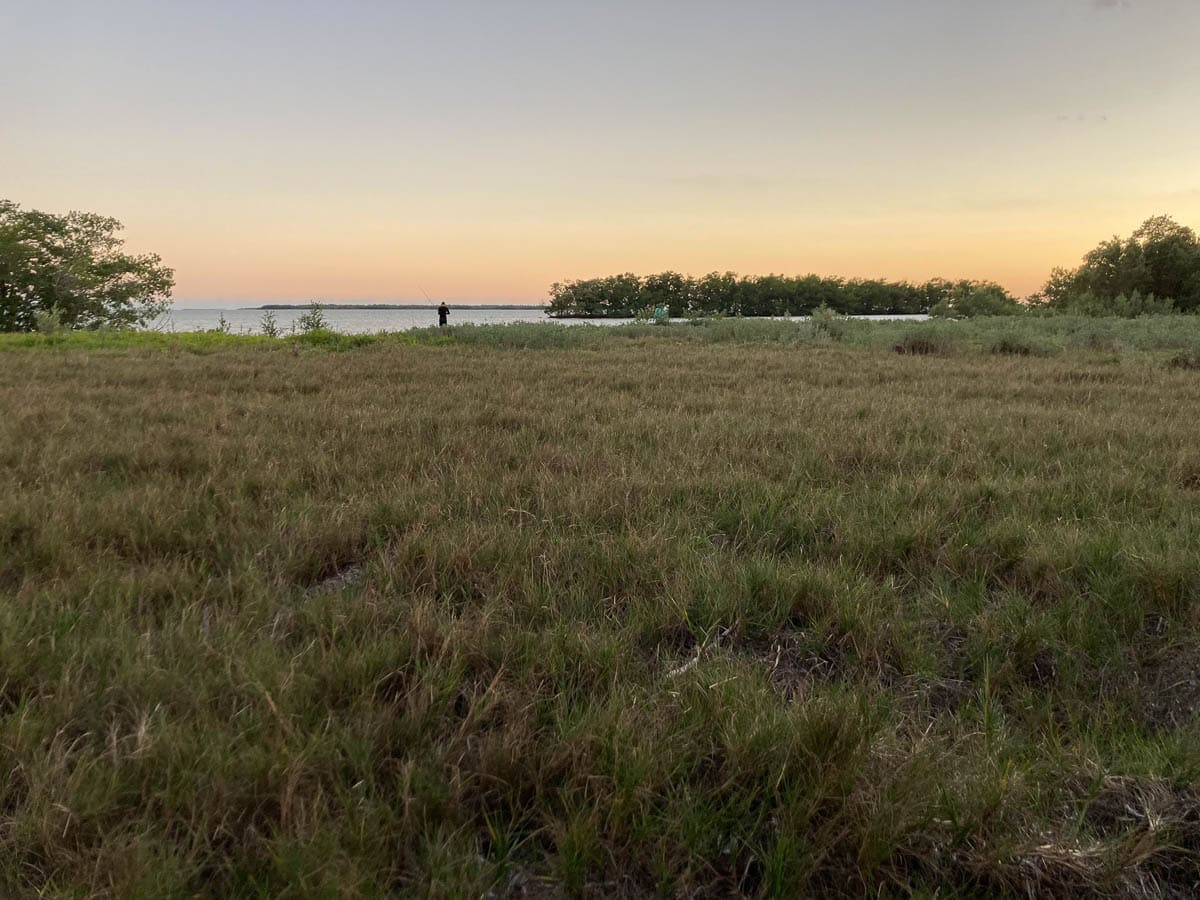
What Is the Best Time to Visit Flamingo Everglades?
Although you can explore Flamingo any time during the year, the objectively best time to visit Flamingo is winter.
December through February is the busy season in the park. For good reason, since this is the season with the most enjoyable temperatures, plentiful sunshine, less mosquitoes, and lower humidity.
Winter is also the dry season in the Everglades, which means that water levels are at their lowest. This, in turn, means that wildlife tends to congregate around a number of freshwater locations, such as certain ponds and lakes.
So, in addition to very enjoyable weather, winter is also the prime wildlife viewing season in Flamingo and Everglades National Park as a whole.
Are There Flamingos in Everglades National Park?
Yes, although they’re not present in abundance like several other bird species, flamingoes do occasionally visit Everglades National Park. The best time to see these iconic birds in the park is spring.
Your best chances of seeing them are at the Snake Bight Trail boardwalk at high tide. Alternatively, you can also paddle along the Snake Bight shoreline with a canoe or kayak and look for them on the waterline.
Can You Swim in Flamingo, Florida?
No! “Swimming and snorkeling is prohibited in all canals, ponds, freshwater lakes, marked channels, and boat basins inside the park,” the National Park Service warns visitors.
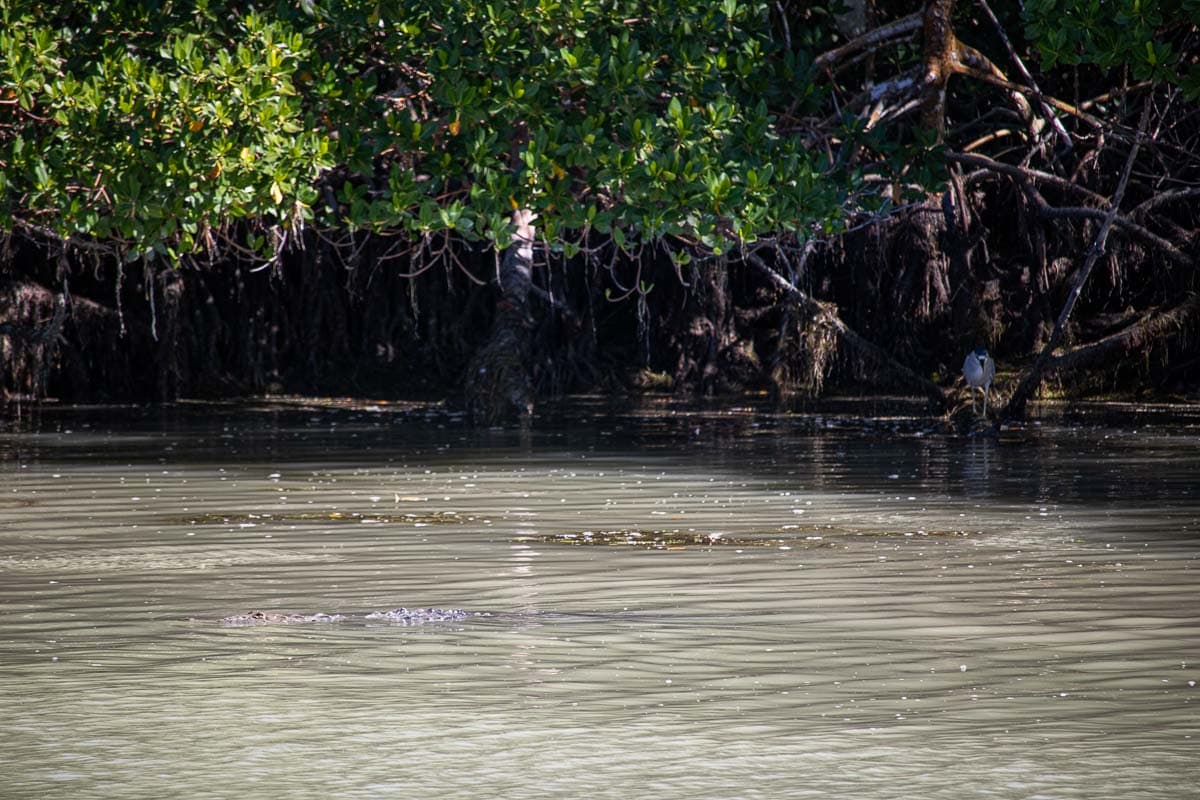
What Gear Do You Need to Visit Flamingo?
Flamingo sits in the middle of the largest subtropical wilderness in the United States. It is at the meeting point of shallow Florida Bay and the interior wetlands.
Therefore, you should expect warm and humid weather—even during the dry winter season, it can still be quite humid and hot outside.
Essential things to bring with you when visiting and enjoying some activities in Flamingo are the following:
- Sunglasses
- Sunscreen
- Hat
- Binoculars
- Camera
- Walking shoes
- Insect repellent
- A cooler with food, snacks, and plenty of water
- Change of clothes (you might get a bit wet if you go kayaking or canoeing) or clothes for several days if you’re staying in Flamingo
- National Park Pass, if you have one (you can buy America the Beautiful Passes here)
Which Visitor Services Are Available at Flamingo?
Flamingo has the most facilities and services of any area in Everglades National Park, including a visitor center, campground, activities booth, and store.
That said, however, I still recommend bringing plenty of food with you and to fueling up your vehicle in Florida City or Homestead before driving down to Flamingo.
In Flamingo, the following services are facilities are available:
- Flamingo Visitor Center – recommended place to start your visit to Flamingo, providing exhibits and displays, informational brochures, maps, and backcountry permits.
- Flamingo Marina – public boat ramp, marina store, fuel, boat tours, bike rentals, canoe and kayak rentals, houseboat rentals, food truck, picnic areas, and walking trails.
- Flamingo Campground – large campground with various sites, bathhouses, picnic tables, grills, amphitheater, and eco-tents.






